LONG-TIME JUNGLE VISITORS will remember Ken Lacy, aka “The Fabulous Orcboy,” who wrote several posts and contributed to many battle reports and campaigns under the old version of this site. Ken is a 40K veteran, a literal scholar, and a true gentleman whom I have been proud to know for over 20 years. I’m thrilled that Ken has returned to wargaming after a lengthy hiatus, and honored that he has chosen to share this experiences and insights with the Jungle. –Kenton
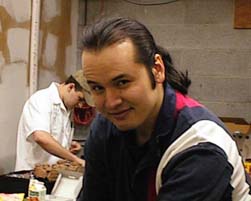
Completing the Sisters
Ultimately, with a few all-day painting sessions in the week prior to NovaCon, I was able to complete the models I had on my painting list. At least I didn’t have a late-night painting session the night before the convention… as I’ve done in the past. I take this as a sign of greater maturity and better time-management than my younger self.

The units that took the longest to paint were actually the Dominion/ Retributor combined squads, as I was attempting to emulate the (lovely and quite detailed) paint scheme provided by my good friend Chris, who (again) is a far better painter than myself.
The gold-armored Sororitas that I’ve named the “Sisters of Autumn Mist” were the easier of the two units to complete, both in terms of color-matching and detail-work, but still involved a lot more shading and edge-highlighting than I typically do for color schemes I design and paint on my own. The original five models show much subtler color blends, and much greater individuality, but on the table-top, all sixteen models readily match up and are definitively a single squad. As they say, good enough for government work.
In fact, one of the things that all five of my opponents commented on – and appeared to very much appreciate – was how easy it was to distinguish between different units in my army, especially when I had units next to each other, or layered in ranks behind each other. The bright colors – you can tell that I got into 40K back in the colorful ’80s and ’90s — also meant that they stood out on the battlefields. At NovaCon, the boards were modeled as blasted ruins and urban areas that were largely various shades of brown and dark grey, and thus my brightly colored models were easy to see and count, again to the approval of my opponents.
Ultimately, I’m glad that this is a net positive and makes for a friendly wargame, though note that my underlying motivation is a rather strong aversion to trying the match and paint the same color scheme on dozens of units.

Having said that, painting eleven blue-armored “Sisters of Aquarius” took me by far the longest to complete: about twenty-four man-hours of work, spread out over three weeks. In fact, I had to take regular breaks and paint other models (not just Sisters models, but also Battletech units as well) just because of how time-consuming and tedious I found it to include all the fiddly detail-work necessary to emulate the original five that were painted for me. I am definitely not a fiddly detail-work kind of painter!
In the end, I stopped and called it “done” when I realized that additional detail work was unlikely to improve the quality of my copies very much, but was very likely to just add more frustration for me. Like with the gold-armored “Sisters of Autumn Mist”, my copies are perfectly decent on the table-top, but if you look closely, they don’t hold up to the originals. Still, this is a good example of the 90-90 rule in action.

My two characters for this Sisters army are very basic in overall paint scheme. The Dialogus/Dogmata proved equally useless in every game I fielded her – I can see why the Interwebs considers only the Hospitaller to be at all useful as a minor character upgrade – so I’m glad I didn’t put hours and hours of work into her painting.
The conversion itself was also quite straightforward: it’s a simple arm-swap with an old Mordheim Sisters of Sigmar model: that’s the origin of both the hammer and the raised fist. A steel metallic dry-brush and purple wash, a little clean-up work, and one Sisters minor character complete! Maybe in future armies, she can be a Hospitaller or even Palatine.
Inquisitor Powers was a modest clean-up of an old Rogue-Trader model I owned, and one of the first 40K models I had ever painted. Those hand-sculpted and hand-cast 1980s models are very low-res, so I put some effort into a giant Union jack design on the overcoat, and otherwise just tweaked a few of the colors (and added a quick wash to the face and chest) before calling it a day. In the future, I’m likely to switch back to the more characterful non-GW sculpt that I’d been using before, but for a tournament the model above was perfectly fine: and also easy for opponents to pick out and spot.
Amazingly, Powers managed to avoid in-game death in two of the five games I played in, but still got torn to pieces when assaulted by Possessed, Warscythes, and an Ork Warboss on a giant Dinosaur, respectively. As I suspected, those three opponents who ‘took out’ Inquisitor Powers all found the experience to be tremendously satisfying, and not just because it was worth quite a few victory points for themselves.
And also, the “Mystery Machine”, the third Immolator from my collection that I’ve assembled. This model is a modest conversion, combining an old Rogue-Trader-era Rhino chassis with a fourth or fifth-edition Immolator top and turret (I purchased the bits separately from a bits-seller). The current Immolator kit is far more ornate – nothing wrong with that, but the over-the-top gothic design is not really my style. Regardless, you can see from this and my other paint jobs how I tend toward bright, anime-inspired schemes with large blocks of contrasting colors.
And since I’m trying to capture the VW-van vibes of the 1960s counter-culture when painting all my Rhino-based vehicles, this meant that the three-color Scooby-Doo van was the perfect inspiration. As the proportions of a Rhino are quite different from a VW bus, I flattened out the light-blue-and-green design a little, and colored the Sororitas Fleur-de-Lis in bright orange, mimicking the hippy flowers of the Scooby-Doo vehicle. Along with the two I’ve already painted, these three Immolators were some of my most useful units at NovaCon, and if I play more Sisters armies in the future, I will definitely focus on painting up some more of my Immolators.
Courtesy of some Blood Angels friends of mine who were upgrading their Rhinos and happy to dump their older models with me, I have enough chassis as well as assorted Immolator bits to easily field four more of these handy transports. Short of megabattles, I can’t imagine ever needing to (or being able to) field more than six or seven Immolators in a standard game of 40K, but they’re so useful that I’d happily bring more than the three I already have painted.
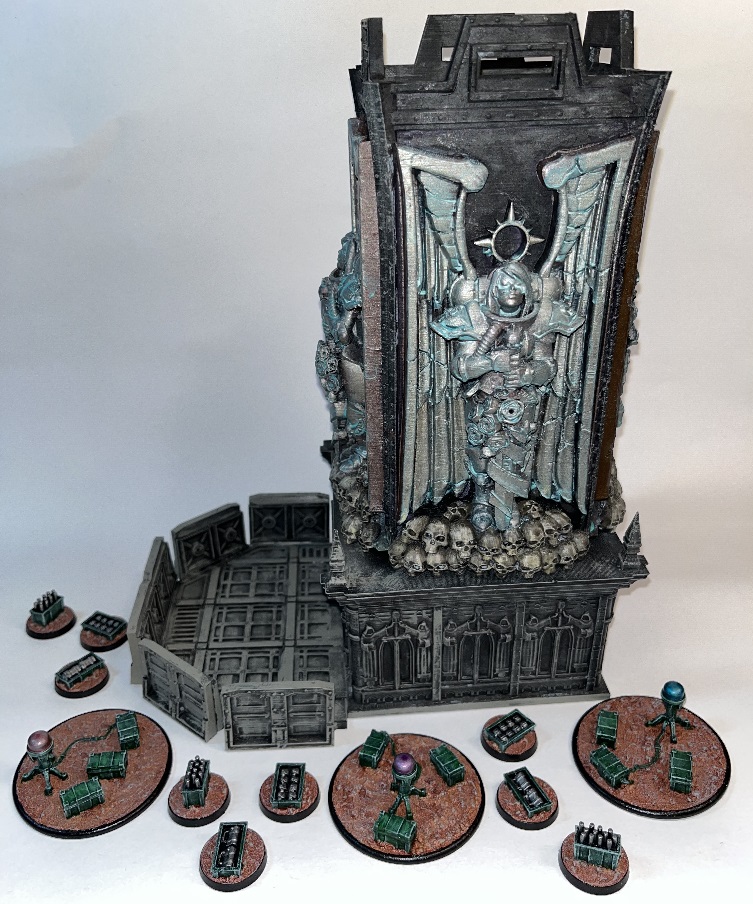
The Narrative campaign asked every participant to bring along a set of three objective markers, even though it proved unnecessary, because ultimately, every table was provided with either modeled objectives, or clear plastic objective markers. Nevertheless, I threw together the three objective markers shown above (they were an add-on sprue to one of the sci-fit infantry kits sold by Wargames Atlantic), and also assembled and painted nine ammo-crate markers, which were intended to be used as Cherubim by the various Sisters units.
Ultimately, I only used those crates as Cherubim in my first game, because the extra models and bases on the tabletop proved needlessly fussy – in my other games, I simply kept track of Cherubim by marking off their use on my army list, which I offered to show my opponents if they desired. Given that we were all playing non-competitive non-tournament games, this never proved to be an issue.
As to the models themselves, they were a cinch to paint, but also surprisingly fiddly to assemble. For some reason, Wargames Atlantic decided to model each ammo crate in three pieces, and also modeled each individual piece of ammunition separately… like one of those hyperdetailed scale model historical tank or airplane kits. Still, I now have generic objective markers and generic 25mm markers if I need them in future games, so… that’s handy?
Also visible in the image is the giant Sororitas-themed dice tower that my friend Chris 3D-printed, assembled, and painted for me to use in the tournament. Because I’m a forgetful bugger, I kept forgetting to pack it and bring it along to NovaCon, but it makes a suitably epic piece of terrain, and it definitely has pride-of-place on top of one of my bookshelves at home.

Finally, the major focus of my painting efforts: three units of Novitiates. As I feared, the Novitiates proved to be absolutely, abysmally useless in every game I played. Or rather, they did manage to serve a purpose in most games, but there was literally nothing they did that a standard Battle Sisters unit could not have done better.
They died in droves when attacked by Chaos melee units. They died in droves when attacked and shot up by Necrons. They died in droves when assaulted by Orks, and they died in droves when scythed down by murderous Chaos Titans. Battle Sisters would have had slightly better armor saves (+1 better, which would have nearly doubled their odds of survival in many cases), better weapons options all-around, and would have generated Miracle Dice while claiming objectives, all for +20 points of cost differential.
Yes, Novitiates can take melee weapons and double the number of their… <check datasheet>… Strength 3 melee attacks with no AP. So, hardly a viable alternative to Arco-Flagellants (point-for-point, slightly more attacks but at S5) or Repentia (point-for-point, same number of attacks as the Arco-Flagellants at Anti-Infantry 4+ and -1 AP, or alternatively half as many attacks but at S6 -2 AP D2).
In conclusion… unless the Novitiates see a (further) drastic cut in points, or gain some alternative options or changes in their datasheet (like maybe gaining the Battleline keyword, or further increasing their melee attacks, or bumping their OC to 3, or increasing their maximum unit size to twenty… or several of these changes simultaneously), then they just don’t have much utility in the Sisters army list.
Having said that, I’m still glad to have finished painting these units. They’ve been in a perpetually unfinished state for well over a decade: primed and based, and with skin-tones painted, but otherwise primer grey. And even if they’re basically useless as Sisters models, they still work just fine as generic post-apocalyptic or cyberpunk gangers (a la Necromunda), or as sci-fi conscripts (a la Astra Militarum), or anything else you could need a collection of Mad Max themed 28mm female gunslingers for. So, they’ll probably end up sorted into my vast collection of Imperial Guards, and add a little more variety to the mix.
Plus, between these models I’ve now finished, and the existing set of Escher models I’ve already painted for my Imperial Guards, plus some classic Rogue Trader models and a recent purchase from alternative-sculptor Victoria Miniatures, I’m well on my way to painting and fielding an all-female Astra Militarum army. Either they’ll be one way I can shoehorn a little diversity into the 40K universe… or they’ll serve just as well as sci-fi grunts in any number of other wargames on the market. Infinity, anyone?
The overall effect of these three units on the tabletop is a bit of a harlequinade, an absolute riot of color, but I’ve arranged each of the three units of Novitiates I completed in the intended array, including all supplementary units (like the Preacher-equivalents, the alternative non-GW sculpts, and the heavy stubber-carrying models), so that it’s a bit clearer what I was planning when I painted their rainbow array of hair colors.
As noted in a previous diary entry, it’s the most obvious modern equivalent to the 1960s counter-culture ideals of “Free Love”, while also helping to highlight the major design feature of these classic Necromunda Escher models: the striking and often sizable hairstyles. Also featured is a variety of different skin-tones throughout each unit, just because I thought it might be an interesting reflection of modern American diversity to mix it up a little, especially with models like these Escher, which have quite a bit of visible skin on their arms and midriffs (as opposed to just the head and/or hands, as is the case with nearly every other GW model).
So that’s a final look at all the models I completed in August 2023, and brought with me to NovaCon. Now, on to the first game!
Game One (2000 pts)
Opponent: Paul (Chaos Marines)
My List: Pious Celebrant Mandate (Inquisitor+Sisters+Immolator, 3x Novitiates, 2x Battle Sisters, 2x Dominions+Immolator, 2x Seraphim, 3x Exorcists)
Table: Fortuno – Grand Library
Planetary Objectives: Five zones spaced equidistantly (2x per deployment, 1x no-man’s land). Friendly units on objectives can forgo further actions after Movement phase in order to ‘brute force’ control of an objective.
Battlefield Objective: Both sides roll 5D6 at start of game and places the individual dice to one side. At end of your Movement phase, one friendly unit on every objective can roll D6 or 2D6 if you control that objective (forgoing all further actions that turn and cutting their Objective Control in half). Compare results to the dice roll at start of game and save any matches; once you have matched all five dice, you have ‘decoded’ the intel and must nominate a friendly unit on the objective that rolled the final matching die to ‘carry’ the intel. Winner of Planetary Objective automatically gets the intel; loser of the Planetary Objective must return intel to their deployment to get intel. Side which gains intel is the ‘winner’ of the battle, or it is a tie if neither or both sides gain the intel.
Campaign Objective: At end of your Movement phase, if you control no-man’s land objective and at least one home-side objective, gain +5 VP
This was my first game with the 10th edition rules, and also my first game of the NovaCon weekend. I drove straight to the venue from New Jersey, and parked in one of the more insane underground parking lots I’ve ever seen; amazingly, I managed not to damage my sedan weaving through all the pillars and sharp underground corners. I registered (with no problems! The Nova Open folks were well organized and very helpful!) and headed down to sign in at my event.
Then, I waited. And waited. And then waited some more. Let’s just say that the event coordinators were fairly relaxed about timeliness of participants and of game start times, and that on the whole, punctuality wasn’t a major issue (although this was also helpful at times, as you’ll see when I describe my Game 4 of the weekend). But a bit disconcerting when I’d rushed down to Washington DC to make it to the event at the scheduled time.
Ultimately, I was placed on one of the “Defend the Planet” teams, named “Those Clowns in Congress”, and met my team-mates: Zack with Eldar Corsairs, Will with Chaos Knights, David with Imperial Knights, Bill with Chaos Demons, and our two Warlords: Craig with Rainbow Warriors Space Marines, and Jason with Chaos Space Marines. All nice enough fellows, but a bit awkward for me as I discovered that I’d apparently missed out on a month or more of trash-talking and socializing on Discord prior to the convention.
Not a problem, though — I volunteered my Ecclesiarchal forces for the meatgrinder, and was assigned my first game: assaulting an ancient (possibly pre-Heresy) library on the planet of Fortuno with 2000 points of Sisters of Battle, and accessing its data archives for the Maltese Falcon…. I mean for vital MacGuffin data that would gain a campaign advantage for whichever side acquired it.
The table itself was beautiful! It featured a massive Egyptian-style temple on one side (perfect for long-range firepower… which neither of us really had much of, so neither of us really used), and a central walkway marked with pillars and two giant archways. A smattering of craters and ruins provided more cover around the table, and five radio towers marked the locations of both the objectives, as well as the “data terminals” that we would be trying to hack throughout the game.
My opponent was a soft-spoken fellow named Paul, who was clearly an experienced tournament player, but wanting to ease himself (and his list) into 10th edition through a narrative campaign. He was extremely patient with an opponent who obviously didn’t know much of what he was doing (= myself). In accordance with my plans, I pulled out my 2000-point of “Anti-Marine” Sisters, the Anointed Angel Mandate, to face off against his Chaos Marine list. In total, Paul was fielding:
- A Chaos Lord (his Warlord) with some kind of Aura, with a retinue of Possessed
- A Warpsmith
- A Chaos Helbrute Dreadnought
- A Chaos Venomcrawler
- Two small units of Chaos Raptors with jump packs
- A chunky unit of Obliterators
- Two small units of Chaos Chosen with a mix of assault and melee weapons
- Two Chaos Spawn
Against this task force, I had 91 infantry models (you can see the list in the summary above), while my opponent had about half as many, and initially I felt I had a reasonable shot at slowing down his (obvious and aggressive) assault with the combined firepower of my Sisters.
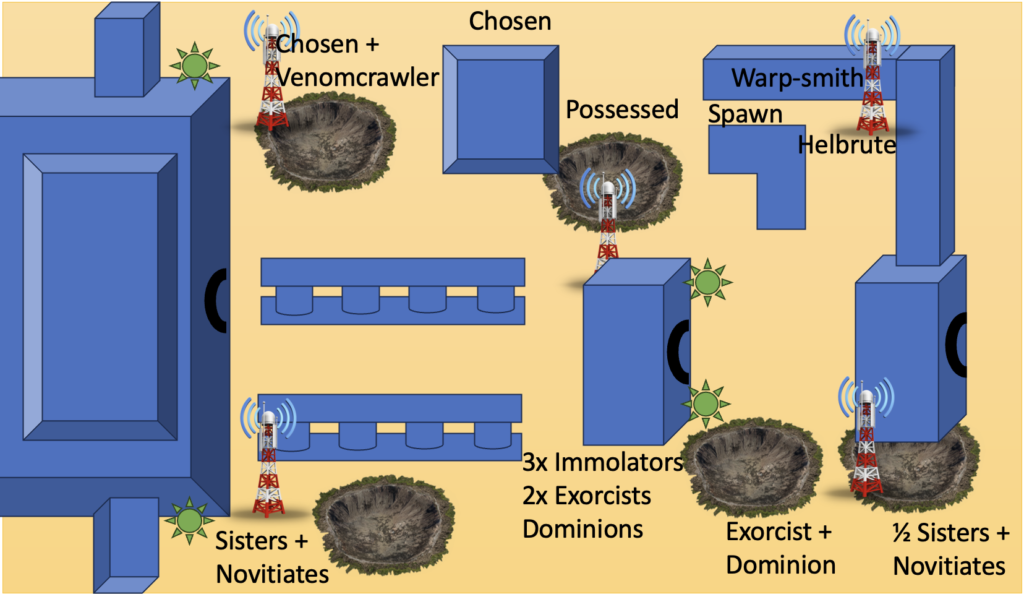
Then I made the first of three major mistakes this game, two of which guaranteed my loss. I decided to split my forces to either side of the giant archway that dominated the center of the table. I figured I had the mobility between assault weapons and transports to maneuver quickly around it – but had not counted on the fact that Paul’s Chaos Army, despite being on foot, was actual FAR MORE MOBILE than mine, because of their Chaos stratagems.
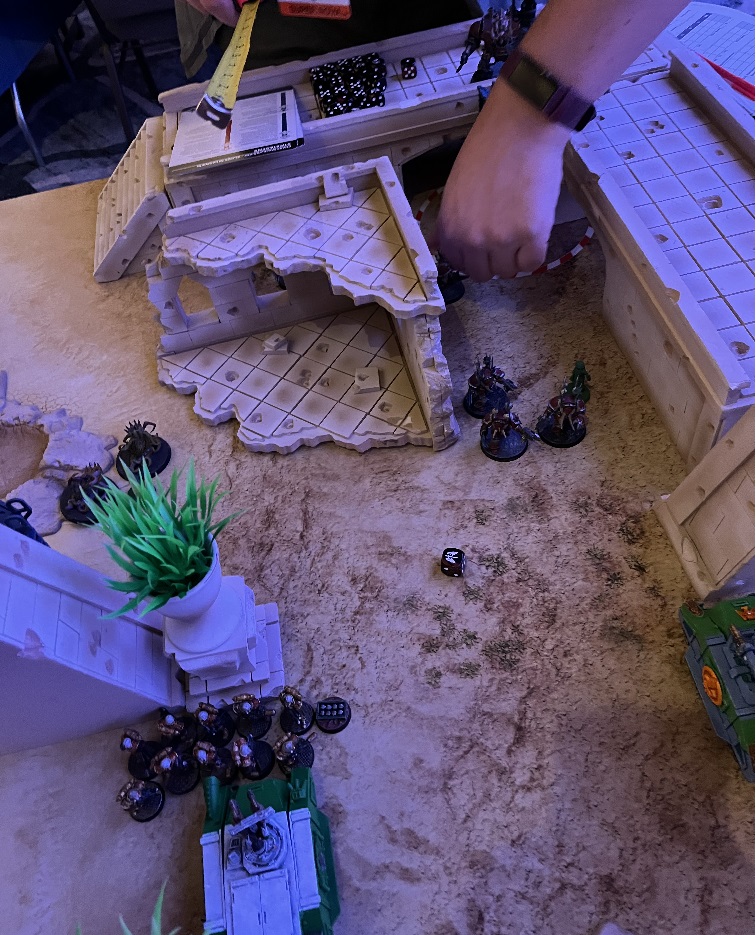
Secondly, after winning the roll to go first, I wasted my entire first phase by largely ignoring Paul’s Warlord and Retinue. I was thinking to thin out his other units and go for objectives, but all I had done was make it easier for Paul’s Death Star unit – his Possessed with high Toughness, multiple Wounds, good armor saves, good invulnerable saves, Feel No Pain saves, and Regeneration – to smash through my units with near impunity over the coming turns.

It took only one Shooting phase (in my second turn) to realize that I really couldn’t put much of a dent into Paul’s Death Star, even if I was to pour the entirety of my army’s firepower into them. By then, it was much too late – I hadn’t set up any units to “feed into” the meatgrinder and slow them down, I wasn’t familiar enough with the 10th edition rules to avoid close combat shenanigans (like Consolidation moves) that would allow the Possessed to eat through multiple units of mine at once, instead of just one at a time.

The third mistake I made was that I was substituting Miracle Dice *after* I had rolled my dice rolls. This is explicitly against the rules, but ultimately made no difference whatsoever, as I spent the game getting utterly slaughtered. The massacre did mean that I racked up quite a few Miracle Dice, of course — but in future games, I made sure to substitute my Miracle Dice before the dice roll, as I am supposed to.
Despite how handily the forces of Chaos had things under control, basically from jump, there were some moments of great spectacle: my Seraphim descending from the heavens to BURNINATE his Raptors, then juuuuuust managing to chop down his Warpsmith in desperate melee combat. The Exorcists tearing chunks out of his veterans and blasting his Helbrute to bloody shreds in the back lines. The Immolators swooping around the battlefield and dropping buckets of fiery dice onto his exposed units. But he protected his walkers well, and I simply didn’t have enough firepower to drop either of them… and his Possessed were basically untouchable.
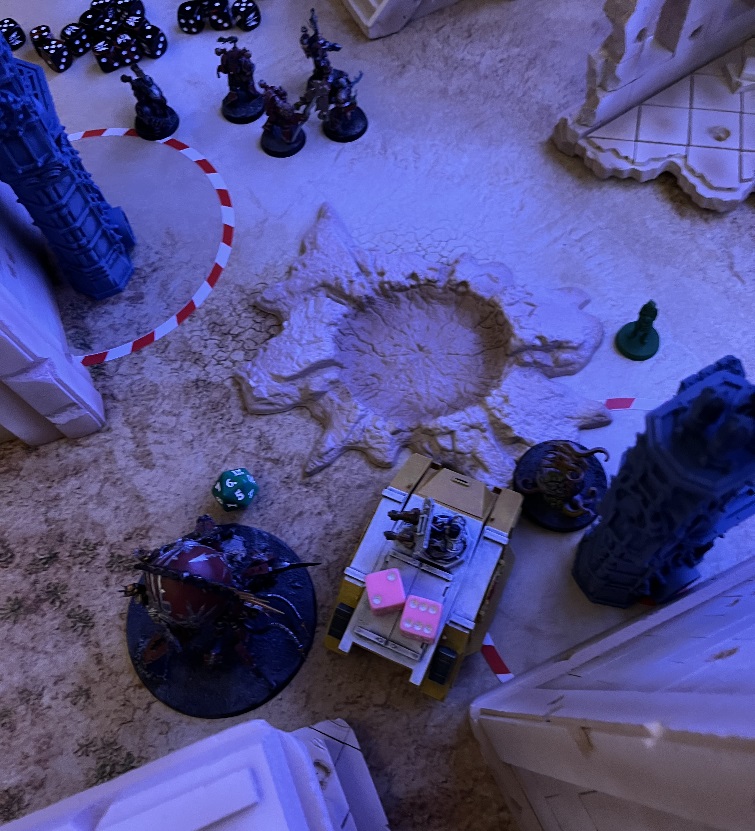
In the end, Paul had almost completely wiped out my back line and left flank, while I had managed to destroy less than half of his units. Despite the disappointing result, I did manage to tie up his Chaos Spawn with an Immolator in the center of the field. The Battle Sisters hiding inside the Immolator meant that I kept control of the center objective, giving me multiple opportunities to try to decode the ancient data… but neither of us could quite crack the code.
Amazingly, this meant the outcome was a split decision: Paul ran away with the Victory Points for Objective Control, having virtually tabled my army, while I was able to gain very slightly out-point him on the hidden (secondary) mission, by grimly outlasting him on the central objective for the entire game.
